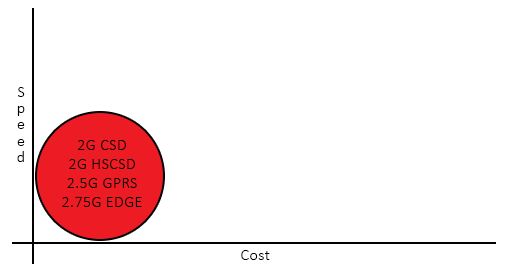To identify the ideal Industrial Cellular Modem for your application we have developed the Modem Selector Tool which is a configurable filter to narrow down the results to match your exact requirements.
2G refers to the second generation of cellular communication technology which was based around the global system for mobile communications standard (GSM). 2G uses digital radio signals to communicate whereas the previous version of the standard (now referred to as 1G) used analogue radio signals and has since been obsoleted.
The benefits of using a digital standard to communicate means that in the 2G radio network voice conversations were encrypted, additional digital services such as SMS and GPRS were possible and the system is much more efficient in operation.
As the digital channel is encrypted, all the associated services are also encrypted meaning that SMS messages, MMS messages and GPRS data services are all encrypted in a secure environment so that only the intended recipient can decode the received information.
The 2G spectrum is essentially split over two different regional areas, each of which having two bands in each territory. These are split in to the European and North American bands. The EU frequency bands are 900MHz and 1800MHz which offer further distance for 900MHz and higher data rates for 1800MHz. The NA frequency bands are 850MHz and 1900MHz which offer further distance for 850MHz and higher data rates for 1900MHz. In practise both frequency bands operate to provide the same maximum data rates.
The evolution of 2G has provided faster data connection services over time but originally only circuit switched dial-up (CSD) was offered on the 2G platform to provide up to 43.2k download data rates. Shortly after this the general packet radio service (GPRS) was introduced to provide packet based communication commonly referred to as 2.5G. GPRS offered speeds up to 85.6k download data rates. Following on from GPRS was the enhanced data rates for GSM evolution (EDGE) which was introduced to offer the same sample rate but increased the number of data bits from 1 to 3 which increased the download data throughput up to a possible 236.8k. EDGE can also be referred to as 2.75G and is the common standard today for the current 2G implementations.
The table below shows the standard operating speeds of the differing technologies on the 2G network.
| Network Technology | Downlink (Kbit/s) | Uplink (Kbit/s) |
| CSD | 9.6 | 9.6 |
| HSCSD | 43.2 | 14.4 |
| GPRS | 85.6 | 21.4 |
| EDGE | 236.8 | 59.2 |

Today 2G is a very low cost solution which makes it a very attractive option for mass market installations such as automatic meter reading (AMR) and road signage etc as the 2G network is available globally and the cost of installation is very low compared with other types of technology.
Many IoT system do not need high data rates and low latency for operation and the low cost 2G network is perfect for fulfilling this requirement. With many IoT solutions a very infrequent untimed data transfer is all that is required, for example in a freezer temperature logging application, if the temperature is logged every 30 mins or every so often after 45 mins it makes very little difference to the overall performance of the solution.
The other benefit of using 2G to send infrequent and untimed data packets is that the running cost of the solution over a monthly or yearly basis is very low due to the billing structure of the 2G network charging per megabyte of data sent. In the logging example above the system might only send 4-5 bytes per transaction if it is highly optimised. On a system that sends a 5 byte message every 30 mins this would equate to 87k bytes of data transfer per year. With a billing structure of £1 per megabyte this would cost 8.7 pence per year therefore the overall solution cost would be considered to be very cost effective.
The problem facing the 2G network is that it is being slowly phased out across the world due to newer technologies becoming available such a 3G and 4G / LTE which offer enhanced connection speeds, lower power consumption and additional user services.
The 2G network has already been shut down by a operators in a number of territories across the globe including AT&T, Telstra, Optus, Vodafone. There are plans to continue running the 2G network in certain regions until a number of specified dates going out to 2019, 2020 and 2025. However the point is that the 2G network will not have any more investment from any vendor and will not be being updated when cell towers go down. Therefore it is not recommended as a solution for new designs or for upgrades.
However, there is still a strong market for the 2G network in existing territories and there are still a huge number of nodes in the field which need to be slowly replaced with newer technologies or replaced with the same 2G solution.
